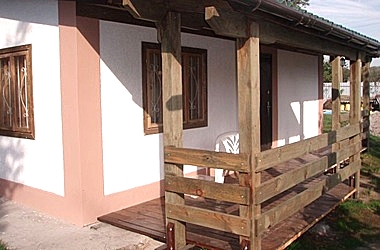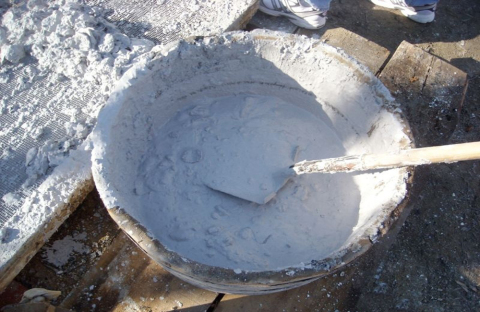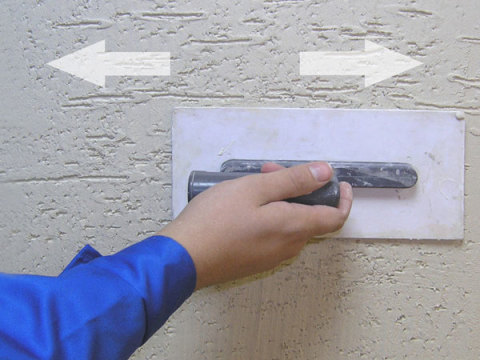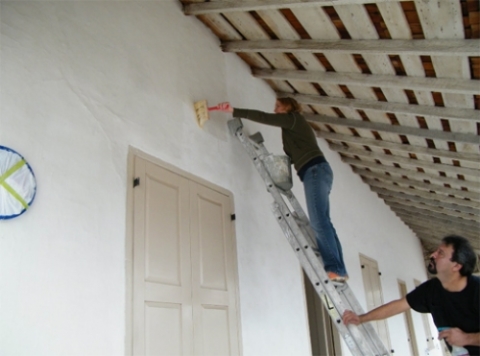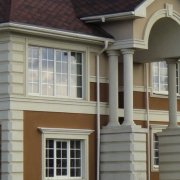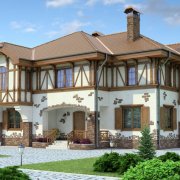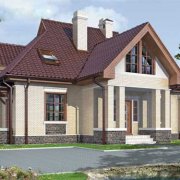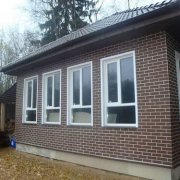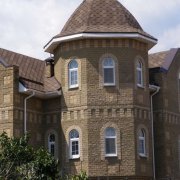Whitewashing of the outer walls - we bet you didn’t know much
Whitewashing the walls on the outside of the building is not done so often. This material is a thing of the past. Although if you take cottages or industrial premises, then here this coating material is used not so rarely.
As components of the application, whitewashing of the walls with chalk or lime is used. The second option is the most common. Today we will consider this issue in detail. Also, a video on how to whitewash the walls you can see the details of this work.
The content of the article
Whitewashing houses: advantages and disadvantages
Whitewashing for walls is to dilute lime or chalk in water and apply a liquid mixture to specific areas of the building. It is this coating that will serve as a defense to the building.
In today's world, this method of decoration is not popular among the population. However, there are still summer residents who adhere to the traditions of the past generation.
| Advantages | disadvantages |
The advantage of whitewashing buildings is as follows:
| Before you whitewash the wall, you need to know the negative qualities.
|
It’s worth mentioning that almost any walls can be used for whitewashing. Even the whitewashing of adobe walls is done. But this is more complicated. After all, straw is such a material that must be carefully prepared.
If you are thinking how to whitewash a water-based wall, then this is done on the principle of chalking or lime. The principle is the same and will be described below.
Principles of working with limestone material and application rules
To whiten a building using lime means that you need to apply a previously prepared mixture to the facade. For this a base plane must be prepared. It should be flat. After all, the coating will repeat all the unevenness.
Attention: Before you start whitening, you must definitely primer the foundation of the facade, wait for it to dry completely, and only then manually or with the help of special devices, start whitening.
House whitening tool
You can whitewash the surface of buildings only in the evening or in cloudy weather. Due to the fact that lime is not resistant to high temperature, it is necessary to avoid exposure to the sun during operation.
Caution: The composition should be uniform, there should be no lumps or clots. So when mixing it is worth using a drill with a nozzle. Then the mass will be homogeneous.
So:
- If you chose a brush to apply the material, then it must be wet. For some time before work, leave the brush in a jar of water so that its wooden base swells and particles of bristle do not remain on the surface that has already been whitened.
- According to the technology of applying whitewashing on the facade of the house, it is required to cover the base in several layers. The first layer of lime is distributed in horizontal strips. The second layer is applied after the first has dried. However, it is superimposed from top to bottom, that is, perpendicularly.
- If a dispenser is used when bleaching a building, then the rule should be strictly observed. The lime mortar is distributed using the apparatus at right angles. This is necessary for economical material consumption and uniform coverage of the entire surface.
Cooking composition
Prepare a lime solution is not difficult. The composition of the mixture should include the following ingredients: hearth, slaked lime, wallpaper glue, table salt.
- Take a medium-sized container, pour lime there in the amount of 3 kg, mix with 1 liter of water, add 100 g of salt and glue.
- Thoroughly stir the resulting mass, that there were no lumps. After we add water, until a total volume of 10 liters is obtained.
- Wallpaper glue will give the solution a sticky property, due to this, it will be better to lay whitewash on the surface of the wall.
- Salt is added to prevent hands and clothing from getting dirty when touched.. You can also add blue, then the solution will turn out to be snow-white.
Caution: It would be nice to wet the surface of the wall before starting work. Then whitewashing will be better applied and held.
Lime whitewash principles
Before there, how to start any work with whitewashing, it is necessary to prepare the foundation, so that the whitewash lies well, and after that there are no flaws:
- Before starting work, the surface must be cleaned. It is forbidden to apply this material on substrates with rust, bumps, and also with efflorescence and greasy spots.
- If there are cracks on the surface, they must be processed and close up. The old whitewash must be removed, can be removed using a special brush. The entire surface is fully plastered (seeHow is plastering the facade of the house) and after it is primed. Before applying whitewash, it is necessary to cover with a film all objects that the solution did not get on them.
- You can use a brush to process small surfaces (seePaint brushes: which ones to choose) And in large areas, rollers or a spray gun are best. Using a brush is the easiest and most cost-effective way.
- As written above, the brush must be soaked in a jar of water, so that the villi do not fall on a whitewashed surface. It depends on what the final result of the work will look like.
- A large area uses a spray gun. Working with such an apparatus requires compliance with the rules for applying whitewashing. The distance between it and the place of application should be about 30 cm, and sprayed at right angles. Then the material consumption will be small, and it is economically viable.
- Not everyone has the opportunity to buy a device, then an ordinary vacuum cleaner can be an analog of a sprayer.
Professional Tips
How to whitewash the walls with whitewash and what to consider, experts can tell. Their advice has a lot of useful things.
Caution: Milk of lime is the best way to disinfect ceilings and walls.Prevents mold, mildew and bugs in the house. To make the mixture, we use water in an amount of 1 liter and extinguished lime in the amount of 3 kg, mix them in containers
So:
- If you want to get a boiling white color, then add a little blue to the container with the mixturewhich is used when washing things. So that the already whitened surface does not stain anything when it comes in contact with it, add ordinary salt in the amount of 100 grams.
- If you want to diversify the color scheme of whitewash, you can use pigment. It is worth noting that should be resistant to calcareous material. For one kilogram of lime add 100 grams of pigment. For example, stable pigments - chromium oxide, soot, umber. Before adding pigments to the lime solution, they must be separately diluted in water. Stir the pigment until a homogeneous mass is formed and leave for five hours. Then add the resulting mass to the lime mixture with thorough mixing.
- To reduce the possibility of cracking or swelling of the material on the surface, add 10% wallpaper glue. Then the solution will have ductility and stickiness, it will lie better on the wall.
- Prior to whitewashing, water must be applied to the surface.. The first layer is applied in horizontal lines. It should dry, and then apply the second layer perpendicularly, that is, from top to bottom. Craft should go evenly.
- Lime is not resistant to high temperatures, so do not get to work in the heat. Also not resistant to sun exposure. This material is best applied in cloudy weather or in the evening.
- Material consumption per square meter is a little 200 grams.
- Prior to whitewashing, apply a primer to the entire base.let it dry. And then start whitening
What to whiten the walls you now know and can do it yourself. It is also worth watching the video in this article and photos that will help you do the job correctly and provide for everything. The instruction is completely correct and if you adhere to it, then the coating will be applied efficiently and quickly.
